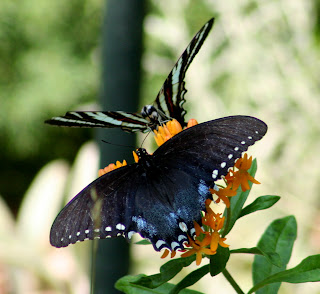
Photo: June 21, 2008
Yesterday I was delighted to see this Zebra Swallowtail (Eurytides marcellus) on the butterfly weed. It is not very common because the caterpillar only feeds on the Pawpaw tree. I think I have seen only a couple of these trees on our land.

Photo: June 21, 2008
Here, a Pipevine Swallowtail feeds with the Zebra Swallowtail. I also saw a Tiger Swallowtail this morning along with the numerous Fritillaries.
The easiest way to grow Butterfly Weed is to find a good stand of them in the wild (along roadsides and old fields). Late in July and early August, you can collect a seed pod which has hundreds of seeds. Plant these in average soil (not too rich or wet) and they should come up next year.

Photo: June 17, 2008
I spotted another Wood Thrush nest only about 50 feet up the driveway from the previous one from the post My Promise to Wood Thrushes. That nest is empty now but at the time of the photo, there were a couple of birds in the nest, ready to fledge.

Photo: June 19, 2008
I caught this hummer in flight as she fought with the others for a place at the feeder. I have been filling up the feeder once a day because the hummers are sucking it dry. Previously, there was a lull at the feeders of about two weeks when the Japanese honeysuckle was in bloom.
Wow...that Zebra Swallowtail is LOVELY! I'm going to on the look out for those!! Thanks for the tip on the butterfly weed...I'm going to have to look for that as well.
ReplyDeleteThe hummers just started coming to our feeder about a week or so ago.
Great Post!!
The Zebra Swallowtail is so hard to photo. Great job!
ReplyDeleteYour little female hummer is sweet. I love it when they fan their tails in pursuit of nectar. I can hear the chittering now :o)
Especially enjoyed the butterfly photos! Next year I will have to plant milkweed!
ReplyDeleteYour butterfly pictures are wonderful and how beautiful is the Zebra Swallowtail!! I had not know of this species. In my area Common Milkweed grows along the roadsides and it attracts many butterflies and insects. When it is in full bloom (now almost) I visit that area daily to photograph butterflies. Nice post.
ReplyDeleteKerri--since the caterpillar only eats PawPaw, you might find the Zebra Swallowtail close to woods. You should find the butterfly weed a little later (for sure in July) along roadsides or at the edge of pastures.
ReplyDeleteThanks for the note.
Mary--thank you for the note. Yes, I am surprised I was able to get a photograph of the Zebra Swallowtail but he must have been so busy feeding on the butterfly weed.
ReplyDeleteI love the hummers too--thanks for reminding me that was a female (I will correct post)!
shellmo--do plant butterfly weed if you can find it. It will attract lost of butterflies including monarchs although they haven't showed up yet. Thanks for visiting.
ReplyDeleteme ann my camera--The Zebra Swallowtail caterpillar only feeds on PawPaw so if you don't have that in your woods, you won't see the butterfly. Looking forward to seeing your milkweed flower photos. Thanks for your note.
ReplyDeleteI am hoping to one day see a Zebra Swallowtail! I must say that I am very jealous of your pictures!
ReplyDeletemon@rch--I had seen only one Zebra Swallowtail before (last year in the woods). Now, I have seen this one for two days. I do feel very fortunate.
ReplyDeleteNice blog. I stumbled on this old post cruising for butterfly pictures. FYI: that great photo is of a zebra swallowtail and a female spicebush swallowtail. Nice picture, though.
ReplyDeleteK--thanks for the note. I remember I had a hard time identifying that butterfly. Should have known it was a spicebush butterfly since we have a lot of spicebush.
ReplyDelete